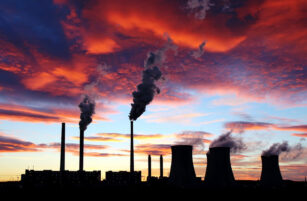Insight Focus
UK power sector emissions fell 12.5% in 2023, while industrial dropped nearly 7%. Across the aviation sector, CO2 emissions rose 13% amid continued growth in travel. UK market has been in surplus since inception.
Emission Drop in UK
British installations covered by the UK Emissions Trading Scheme reported a drop of 12.5% in emissions in 2023, broadly in line with the 15% drop reported by power plants and factories covered by the EU’s carbon market.
Nearly 1,100 covered installations and aircraft operators in the UK reported verified emissions reports for last year totalling 96.8 million tonnes, compared with just over 110 million tonnes in 2022 and nearly 108 million tonnes in 2021.

Source: Gov.uk
Leading the decline was a 12% slump in emissions from electricity generation to 37.1 million tonnes, compared to 48.2 million tonnes in 2022 and 47.3 million tonnes in 2021. For comparison, the European power sector reported a 25% drop in CO2 emissions last year.
Some of the fall in UK power emissions was due to the closure of EDF Energy’s West Burton A coal-fired power plant, which reported 104,000 tonnes of CO2 emissions in 2022 but only 4,181 tonnes last year when it was permanently closed. Just one coal-fired unit remains operational in the UK: Uniper’s 2,000MW plant at Ratcliffe-on-Soar. The power station reported 2.67 million tonnes of CO2 in 2023.
Gas-fired power generation also declined by nearly 12% in 2023.
Aviation, Industry Produce Most Emissions
The change in power sector emissions was mainly due, however, to another strong shift towards renewables in the UK. Data from the UK government showed that total wind power output rose more than 19% year-on-year, while solar generation rose 11%.

Source: National Grid
Emissions from industrial plants totalled 50.9 million tonnes, a drop of 6.9% from 54.66 million tonnes in 2022. Tata Steel’s Port Talbot steelworks was the largest emitter, reporting 5.7 million tonnes, little-changed from last year. The plant is to be shut this year and replaced by electric arc furnaces.
The other major steelworks in the UK at Scunthorpe was the third-largest emitter, while power stations owned by RWE and Uniper rounded out the top five.
The 773 stationary installations reporting emissions ranged from cheese factories to brickworks, distilleries and chemical works.
In contrast, nearly 400 aviation operators reported emissions from aircraft totalling 8.8 million tonnes last year, an increase of 13% compared to 7.8 million tonnes in 2022 and 3.5 million in 2021, when the world was emerging from the Covid-19 pandemic.
Low-cost airline Ryanair was the largest emitter with nearly 4.4 million tonnes, followed by easyJet with 1.8 million tonnes. British Airways reported just over 1 million tonnes.
UKA Surplus Persists
Reported emissions represent total demand for UK Allowances (UKAs) in the country’s carbon market, and in the case of the UK this demand has fallen below supply in each year since the market began in 2021.
In 2023, the government handed out free of charge or auctioned a total of 116 million UKAs, compared to implied total demand of 96.8 million tonnes – a surplus of more than 19 million tonnes. Add to this amount nominal surpluses from the first two years of the UK ETS and it is not surprising that the market price of UKAs slumped to just over GBP 30/tonne at the start of this year.

Source: ICE
UKA prices have since recovered to rate at more than GBP 47/tonne last Friday, reflecting some speculative buying ahead of next month’s general election. The election is widely forecast to bring in a Labour government that may have greater ambitions for the country’s carbon market. It may also be more amenable to discussions over linking the UK cap-and-trade system to its European neighbour.













